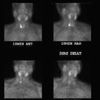Older Woman With Abdominal Pain
For 2 weeks, a 67-year-old obese woman has had episodes of diffuse, nonradiating abdominal pain that last for several hours and are slightly relieved by famotidine/antacid. She rates the pain as 7 on a scale of 1 to 10.

For 2 weeks, a 67-year-old obese woman has had episodes of diffuse, nonradiating abdominal pain that last for several hours and are slightly relieved by famotidine/antacid. She rates the pain as 7 on a scale of 1 to 10. She also has had nausea without vomiting and infrequent dyspepsia/heartburn; the nausea does not worsen with meals. She denies other GI symptoms and recent foreign travel; has not eaten food from local street vendors; and has had no fever, chills, night sweats, or sudden change in weight.
The patient has hypertension and osteoporosis and takes hydrochlorothiazide, calcium with vitamin D, and alendronate. She has no history of drug allergies or alcohol, tobacco, or illicit drug use. She has a family history of diabetes.
The patient is afebrile. Blood pressure is 146/78 mm Hg. Frequent eructation is noted during the examination. Heart and lung sounds are normal. The abdomen is distended and tympanic; bowel sounds are present in all 4 quadrants. There is no rebound or guarding. No abdominal mass or hepatosplenomegaly is noted. Digital rectal examination reveals no significant masses. A stool sample is negative for occult blood.
Results of a complete blood cell count; chemistry panel; liver function tests; measurement of serum amylase, lipase, albumin, and total protein; examination of stool for ova and parasites; and urinalysis are normal. However, the serum total calcium level is 13.1 mg/dL (normal, 8 to 11 mg/dL).
The results of a technetium-99m sestamibi scan are shown here.
To what diagnosis do the clinical findings and scan results point?
- Primary hyperparathyroidism.
- Sarcoidosis.
- Vitamin D intoxication.
- Addison disease.
(Answer on next page.)

Primary hyperparathyroidism
The technetium-99m sestamibi scan revealed a right inferior parathyroid adenoma (arrow). Ten minutes after intravenous injection, uptake was visible in the salivary, thyroid, and parathyroid glands. After 3 hours, the radiolabeled molecule washed out from the thyroid gland and what remained visible was deemed to originate in the parathyroid glands.
A repeated total serum calcium measurement was 12.5 mg/dL; the parathyroid hormone (PTH) level was 107 pg/mL (normal, 15 to 75 pg/mL). The serum phosphate level was low at 1.2 mg/dL. The persistently elevated calcium level and the elevated PTH level confirmed the diagnosis of primary hyperparathyroidism.1
The thiazide was discontinued because it increases renal calcium reabsorption. Calcium was also discontinued. Parathyroidectomy via unilateral neck exploration was performed. The total serum calcium level decreased to 9 mg/dL less than 24 hours after the resection. The resected parathyroid adenoma measured 14 3 15 mm (normal parathyroid glands measure 2 3 5 mm). The diuretic and osteoporosis medication were resumed when the calcium level had returned to normal. The patient was discharged on hospital day 3. At follow-up 1 week later, she was asymptomatic.
Primary hyperparathyroidism most commonly occurs in women older than 65 years.2 Clinical manifestations include anorexia, constipation, peptic ulcer disease, osteopenia, myalgias, weakness, polyuria, kidney stones, anxiety, and depression.1 However, the disorder is often asymptomatic.2 Excessive PTH secretion may be caused by a single parathyroid adenoma (85%) or by hyperplasia of all 4 glands (15%). Familial disorders, including multiple endocrine neoplasia and hypocalciuric hypercalcemia, although rare, should be considered in patients with primary hyperparathyroidism.2
The definitive treatment of primary hyperparathyroidism is surgical resection.2 The traditional approach, bilateral neck exploration, has an excellent cure rate (greater than 95%) and a low complication rate (1% to 2%).3 Damage to the recurrent laryngeal nerve, transient postoperative hypocalcemia, and neck hematoma are potential complications.1 If MRI, CT, ultrasonography, or sestamibi scintigraphy reveals a single parathyroid adenoma, unilateral neck exploration can be performed. Sestamibi scintigraphy is the most effective preoperative imaging modality, with 91% sensitivity and 99% specificity.3
Preoperative localization and intraoperative PTH measurement have made minimally invasive approaches for parathyroidectomy possible.4 If the PTH level does not decrease during and after the resection, the surgeon will search for other adenomas. This helps prevent hypercalcemia from recurring because of missed ectopic adenomas or 4-gland hyperplasia.4 The recurrence rate with this approach is the same as that with bilateral neck exploration.4 Asymptomatic patients with a mildly elevated calcium level (11 to 12 mg/dL) and no evidence of osteoporosis or renal involvement can be treated medically.2
References:
REFERENCES:
1.
Allerheiligen DA, Schoeber J, Houston RE, et al. Hyperparathyroidism.
Am Fam Physician.
1998;57: 1795-1802, 1807-1808.
2.
Taniegra ED. Hyperparathyroidism.
Am Fam Physician
. 2004;69:333-339.
3.
Allendorf J, Kim L, Chabot J, et al. The impact of sestamibi scanning on the outcome of parathyroid surgery.
J Clin Endocrinol Metab.
2003;88:3015-3018.
4.
Miccoli P. Parathyroid surgery: we only need a minimal surgical approach
. J Endocrinol Invest.
2005; 28:570-573.